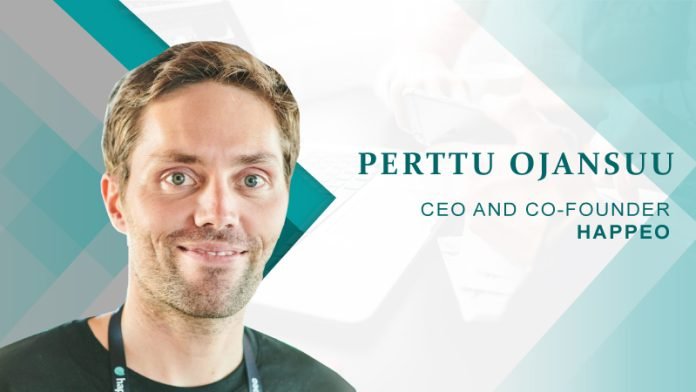Perttu Ojansuu CEO and Co-founder, Happeo explains the role played by technology in establishing stronger employee engagement and facilitating happier workforces.
1. Tell us about your role in Happeo.
As CEO my mission is to make our vision happen – to make work a happier place. That counts for both our customers, but also internally in Happeo. Luckily, I have an awesome team (we call ourselves as Happsters) who support everyone in realizing our company mission.
My work specifically can be divided into these three topics:
● Hiring
● Helping my colleagues to succeed in their responsibilities
● Planning the strategy and organizational communication
Typically, on a daily basis I spend between three and four hours on each of these themes, every day.
When we are fundraising, I’ll turn my focus towards that – and that can easily take several months. After the round is closed, my time goes back to the above topics.
2. Can you tell us about your journey into this market?
It started in 2010, when I co-founded Gapps along with Vesa Sironen and Antero Hanhirova. Gapps is a company that helps companies in Finland move to IT-cloud systems. Running that company successfully confronted me with the every-day work life of people at organizations large and small. See, we spend one third of our life working. Shouldn’t that then be something that we love doing? Instead we spend 20 hours per week combing through emails and 8 hours on searching for information that we need to do our job – instead of actually doing it. That can’t make anyone happy.
That concept has haunted me my entire work life, and it’s what defines my journey. My mission is to make work a happier place, and hopefully by doing that, the world will be a happier place too.
3. How do you think technology is changing the HR Sector?
Technology is affecting HR in several ways. While there’s a lot to it, I think I can sum it up in one term – technology is making it more efficient for people to get more out of their organization, and for the organization to get more out of its people.
I see that happening through four ways:
1. Automation – HR processes are becoming more sophisticated, but less time-consuming as machines can do in minutes what man can only do in hours.
2. Transparency – Centralized systems that store information, are easy to search and bridge communication with collaboration create an organization in which there are no unnecessary secrets. Simply put, if you need or want your employees to know something, they can – no matter where they are.
3. Asynchronicity – We live in the technological revolution. Even without the current pandemic, there is no need for people to be in an office five days a week. This changes the way your company communicates – and that change can bring massive improvements. Asynchronous communication and collaboration means you don’t need to work and communicate at the same time to get something done. This has huge implications for organizational dynamics, and HR needs to champion this together with Internal Comms.
4. Human – With an increasing emphasis on technology, where our jobs get executed 70% through digital means, there is no reason why people would still think of an HR department as “invisible” – a common complaint in large organizations. Automating parts of the actual work, processes and policy execution means that HR people spend less time behind computers, freeing them up to spend more time with humans.
Our relationship with technology is changing. Some believe it makes us less connected and more machine-like. I believe that by making the mundane and repetitive more efficient, we’re creating more space for real human interaction. And it’s with that principle that we continue to develop Happeo as a platform.
4. How is digitization empowering workplace collaborations?
Funny enough, what’s changing HR is also changing the rest of the organization, so I would stick to points 1, 2 and 3 from my previous answer. I believe that collaboration is becoming more efficient and global. Technology allows people from your office in Delhi to work efficiently with your people in Paris. We were able to do that before, but only through synchronous means. Now it’s a different paradigm.
5. What is the significance of a social intranet on employee engagement?
A social intranet can change the game for employee engagement. One central platform offering the chance to interact and the opportunity to learn from each other will enhance a sense of community and achievement. This is especially true with the rise of remote work. Now more than ever employees are feeling disengaged and isolated. While an intranet won’t solve all the problems of Internal Communications, it will go a long way to increase the visibility of people, leadership and the organization as a whole.
Another key thing that it enables is true bottom-up communication. You cannot have engagement with just one-way messaging. You need to give people their own space to process and work with the information you provide them – whether that’s a page with contact information or a video on your Q1 business results.
6. In what way can org-charts amplify employee connectivity?
I think the standard answer is there – you actually see who works there, per department and location. But that just makes things visible, it’s the known unknown. However, add “skill” to the list of things that an org-chart can show and now you’re able to look at the unknown knowns – in other words, it answers questions like “I really need to get this data analysis done with SPSS – would there be anyone online who’s available to help me? ”.
Being able to find people by department and function is crucial, but go a level deeper and search for skill, and organizations and employees don’t just become better connected. They become able to tap that untapped potential by understanding what kind of people exist in the organization at the moment that they need something.
7. Why is an intuitive interface essential enhanced communication via mobile devices?
Mobile devices are a large part of what drove a revolution in User Experience design. Where before everyone was content with command prompts and endless clicks, phones took that option away. They were also catered towards a different, younger target group – one that’s famous for not having a very long attention span, but also being able to filter the relevant from the irrelevant at lightspeed.
That revolution (rightfully) bled into software and how people interact with it. Today, everyone expects to be able to use any piece of software without wading through a manual. If your organization bought a product that requires a lot of end-user training, you’re buying the wrong, outdated thing. The result? Low adoption rates, which means low value for your money. Happeo’s DAU/MAU Ratio sits at 52%, which in human terms means that more than half of people that use Happeo on a monthly basis, do so on a daily basis. That’s considered a world-class achievement, and it’s the reason our customers are so happy and our churn is so low. Our customers are buying actual value and connectivity.
8. Can you explain to us in detail about your advanced analytics product?
Happeo’s analytics shows you who the top contributors and influencers are within your company, and it integrates with Google Analytics so you can create your own custom reports. Happeo’s Advanced Analytics takes everything from the standard analytics package, but goes several steps further by providing in-depth analytics of everything that happens in your own Happeo platform. The overview is so easy, anyone can read its data – no experience with analytic dashboards necessary. Next to that, it includes what I believe is a revolution in the field of Internal Comms: Search Analytics. Search Analytics show you which keywords are most used in Happeo’s Enterprise Search, as well as whether or not those searches return results, how long it takes to fetch those results and more. I’m pretty confident that this package means one thing – Happeo’s Advanced Analytics is one of the most advanced examples of Internal Comms analytics available today.
9. How does Happeo API deliver customized experience?
Our open API allows customers to take more control of their Happeo platform, by integrating it with the third-party tools they know and love. Every organization is different, even if they operate in the same sector. That makes their digital-tool stack different too. For large organizations it’s beneficial to bring their most-used tools, content and processes into their most-used communication and collaboration platform. It’s what enterprises need to create one cohesive digital ecosystem.
10. How do you prepare for an AI-centric World?
I believe that technology allows us to automate the mundane away. Paraphrasing Steve Jobs:
In the industrial revolution, a bicycle was considered “technology”. Inventions like these freed up the human body’s energy. With a bicycle, a human could travel further and faster than ever before, using less energy than you would when walking or running that same distance. Steve Jobs related this to the development of computers, where a computer allows the human mind to do more, with less energy. He called it “the bicycle of the mind”. That’s where I see an AI-centric world heading. That’s where Happeo is heading, as it fits perfectly with our vision of making work a happier place.
Are you ready for a world where machines anticipate and help you accomplish your goals? Isn’t that what every professional’s dream?
11. What are the major developments you are planning, in recent times?
In the immediate future:
We’ve changed the standard in user-first design for social intranets – and we plan to take that a step further with a new User Interface release.
In the slightly further future:
I’ve always said that Internal Communications is the biggest source of untapped potential in business today.
We’re going to continue to help organizations tap into that potential by establishing an entirely new way of working in Internal Communications. More about that next time. 🙂
12. Can you tell us about your team and how it supports you?
Every Happster has gone through a rigorous recruitment and vetting process, because it’s incredibly important to us that we don’t just hire smart people, but we also hire the right people. We’ve not just been recruiting for cultural fits, but we’ve been looking at cultural additions – people that add positive new aspects to our culture. The reason we invest so heavily in a diverse team of happy, high-performers, is closely related to our mission – business today is entirely dependent on their talent, and diverse teams perform better. Cultural fit, variety and additions help you get the most out of your people, and your people get the most out of your company. That’s also how they support me. Everyone at Happeo has ownership over what they do, there is no micromanaging. That requires a high level of discipline, but also gives me peace of mind. If I approach a Happster for help, which I frequently do, then I know that I’m getting help from the best person in the world at that point in time.
13. What book are you currently reading?
These days I listen to books more than I read! It helps me save time, as I can somewhat do two things at once – cooking, for example. Right now I’m listening to Yuval Noah Harrari’s Sapiens, and I’m loving it. It’s fascinating to see how people dynamics have both evolved and not changed at all throughout the centuries.
14. We have heard that you have a very joyful work culture, we won’t mind having a look at some of the pictures?
Of course! Please see our media kit – I would recommend taking a look at the culture videos especially.



15. Can you give us a glance of the applications you use on your phone?I only have a few applications on my phone, but I use these a lot:
● Food-delivery applications (for when I can’t cook and listen to books!)
● Typical consumer mobile messaging apps (to be connected with friends & family)
● Drops, which is an app that forecasts rain – crucial in Amsterdam
● Our own Happeo app so I can stay connected with my team!
For more such Updates Log on to www.hrtechcube.com

Perttu Ojansuu CEO and Co-founder, Happeo
Perttu Ojansuu is the CEO and Co-founder of Happeo. He started in the SaaS industry by building the biggest Google Cloud company in Finland. As companies expanded their digital toolsets, he saw problems in the way they collaborate and communicate, less happy employees. Happeo is the community-powered employee communications platform that Internal Communications, HR, and leaders use to align and engage talent. It is the tool they need to create a high-performing digital culture – fueled by a strong happy employee community.













